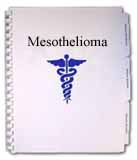|
Mesothelioma and Lung Cancer News - Return to Menu
Resurfacing Recommended for Asbestos-Laden Roads
Crushed or broken serpentine in gravel roads and driveways can release cancer-causing asbestos fibers into the air. The health concern is serious enough for the state's Department of Toxic Substances Control to now recommend those roads be resurfaced.
Serpentine, California's state rock, occurs naturally in 44 of 58 counties. The greenish rock contains asbestos, a cancer-causing silicate mineral. Amphibole asbestos, which has been found in El Dorado County, is especially deadly. When serpentine rock is broken or crushed, it can release minute fibers that can lodge deep in the lungs. Those fibers can cause the almost-always fatal mesothelioma, a cancer that invades membranes in the chest and other body cavities.
The U.S. Environmental Protection Agency considers stone containing more than one percent of asbestos to be unsafe. California law states serpentine gravel can't have more than five percent asbestos.
The DTSC based its resurfacing recommendation on a 2002 study of a serpentine gravel road near Garden Valley in northeastern El Dorado County. The agency sampled air near Slodusty Road under a variety of conditions, including no traffic, minimal traffic and average traffic. The research showed there were significant concentrations of airborne asbestos at all points near the road whenever traffic was present.
The following summer the DTSC resurfaced Slodusty Road with limestone aggregate. The air study was duplicated and results indicated a 98 percent reduction in airborne asbestos concentrations.
Before resurfacing, the DTSC estimated the risk of cancer at Slodusty Road at 3 in 1,000 five feet from the road and 3 in 100,000 190 feet from the road.
In the video link below, News10 reporter Deborah Hoffman has reaction to the recommendation from some El Dorado County residents.
To learn more about the study and its conclusions, read the following below.
CALIFORNIA ENVIRONMENTAL PROTECTION AGENCY
NEWS RELEASE
Department of Toxic Substances Control
T - 19 - 05 Contact: Lisa Gray
For Immediate Release 916.324.0936
April 8, 2005 Ron Baker
916.324.3142
Department Releases Garden Valley Study
Recommends Re-Surfacing of Asbestos Containing Roads
Sacramento --- Citing an elevated health risk associated with airborne asbestos from unpaved roads and driveways, the California Department of Toxic Substances Control (DTSC) today released its findings from a scientific study and recommended that roads and driveways covered with serpentine gravel, which may contain naturally occurring asbestos, be resurfaced.
The study, conducted in Garden Valley by DTSC with the assistance of the U.S. Department of Transportation, John Volpe National Transportation Systems Center (Volpe Center) and the California Office of Environmental Heath Hazard Assessment (OEHHA), concluded that airborne asbestos generated from vehicle traffic may pose a significant health risk and that resurfacing the roadway substantially reduces the amount of asbestos in the air.
The road used in the study was resurfaced and the results showed that airborne asbestos concentrations were reduced by an average of 98%.
“It is our hope that this study and its conclusions will assist landowners and local governments in maintaining public and private roads that contain asbestos rock in a manner that reduces virtually all risks,” said B.B. Blevins, DTSC Director.
Details of the study are available on the DTSC Web site in a final report titled, “Study of Airborne Asbestos from a Serpentine Roadway in Garden Valley, California” at https://www.dtsc.ca.gov/SiteCleanup/Garden_Valley/index.html.
DTSC and Volpe Center conducted the study to measure the level of airborne asbestos fibers released under two simulated traffic patterns on a serpentine gravel covered road – known to contain asbestos. In the summer of 2002, DTSC conducted air sampling while simulating “no traffic,” “typical” and “maximum” traffic conditions. Ten vehicles per hour running at 10 miles per hour (mph) were selected as a “typical” traffic condition and 30 vehicles per hour running at 25 mph were selected as a “maximum” traffic condition.
As part of the study, a human health risk assessment was completed by OEHHA and is a part of the DTSC report. A health risk assessment is a tool used by environmental agencies to determine the level of threat associated with an environmental condition. Conservative exposure assumptions are typically used (such as the person is exposed continuously for a lifetime) so that the risk is not underestimated.
DTSC News Release
April 8, 2005
Page 2
The risk assessment for cancer causing substances estimates the increase in number of cancers in a large hypothetical population and does not predict increased cancer risk for an individual. The risk from similar roads will depend on actual exposure conditions.
The health risk assessment for the study, which was based on measurements of airborne asbestos generated by simulated traffic conditions prior to resurfacing of the road:
• Looked at the risk of cancer from asbestos;
• Estimated significant additional risk of cancer in a hypothetically exposed person from 5 feet to 190 feet from the road;
• Estimated for the typical scenario (10 vehicles per hour at 10 mph) with 70 years exposure, 16 hours per day at 5 feet from the road, an additional lifetime cancer risk of 3 in 1,000 and;
• Estimated for the same scenario for a person 190 feet from the road an additional cancer risk of 3 in 100,000
In the summer of 2003, the road was resurfaced with a four-inch limestone aggregate cover. Another air study was conducted using the same traffic conditions. The results showed that airborne asbestos concentrations were effectively reduced by an average of 98%.
# # #
The Department of Toxic Substances Control’s mission is to restore, protect, and enhance the environment and ensure public health, environmental quality and economic vitality by regulating hazardous waste, conducting and overseeing cleanups, and developing and promoting pollution prevention.
|

































